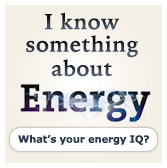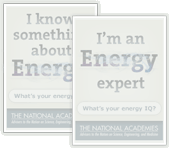
What You Need To Know About Energy
What do you know about energy?
Nuclear power provided what percentage of the total U.S. energy supply in 2013?
-
Sorry, that’s incorrect.
19% of our electricity was generated by nuclear fuel in 2013.
-
Correct!
19% of our electricity was generated by nuclear fuel in 2013.
-
Sorry, that’s incorrect.
19% of our electricity was generated by nuclear fuel in 2013.
-
Sorry, that’s incorrect.
19% of our electricity was generated by nuclear fuel in 2013.
Renewable energy (solar, wind, geothermal, hydroelectric, biofuels, waste, and wood) accounted for what percentage of the total energy supply in the United States in 2014?
-
Correct!
In 2014, 10% of our total energy use came from renewable energy sources, such as biomass, wind, solar, and hydropower.
-
Sorry, that’s incorrect.
In 2014, 10% of our total energy use came from renewable energy sources, such as biomass, wind, solar, and hydropower.
-
Sorry, that’s incorrect.
In 2014, 10% of our total energy use came from renewable energy sources, such as biomass, wind, solar, and hydropower.
-
Sorry, that’s incorrect.
In 2014, 10% of our total energy use came from renewable energy sources, such as biomass, wind, solar, and hydropower.
Which has been growing more, energy used by lighting and appliances or energy used for heating and cooling?
-
Correct!
For decades, more than half of all residential energy use went to space heating and cooling; in 1993, it accounted for nearly 60%. But EIA data show that by 2009, that share had dropped to 48%. And in the period 1993 to 2009, energy for appliances, electronics, and lighting rose from 24% to 35%, owing to the proliferation of appliances, as well as trends toward larger TVs and other devices.
-
Sorry, that’s incorrect.
For decades, more than half of all residential energy use went to space heating and cooling; in 1993, it accounted for nearly 60%. But EIA data show that by 2009, that share had dropped to 48%. And in the period 1993 to 2009, energy for appliances, electronics, and lighting rose from 24% to 35%, owing to the proliferation of appliances, as well as trends toward larger TVs and other devices.
True or False: Burning biofuels does not release carbon dioxide.
-
Sorry, that’s incorrect.
Biofuels contain carbon and although they may burn “cleaner” than oil-derived fuels, they do not avoid generating carbon dioxide emissions.
-
Correct!
Biofuels contain carbon and although they may burn “cleaner” than oil-derived fuels, they do not avoid generating carbon dioxide emissions.
Which residential usage consumes the largest amount of energy?
-
Sorry, that’s incorrect.
Consuming the largest amount of energy, space heating accounts for 31% of all residential energy used. Space cooling accounts for an additional 12% of energy usage.
-
Sorry, that’s incorrect.
Consuming the largest amount of energy, space heating accounts for 31% of all residential energy used. Space cooling accounts for an additional 12% of energy usage.
-
Correct!
Consuming the largest amount of energy, space heating accounts for 31% of all residential energy used. Space cooling accounts for an additional 12% of energy usage.
-
Sorry, that’s incorrect.
Consuming the largest amount of energy, space heating accounts for 31% of all residential energy used. Space cooling accounts for an additional 12% of energy usage.
Which of the following is considered an obstacle to cars running on hydrogen fuel cells?
- Cost of fuel cells
- Difficulty storing and transporting hydrogen
- Process of collecting pure hydrogen
- All of the above
-
Sorry, that’s incorrect.
All of the reasons mentioned are considered obstacles to producing cars that run on hydrogen fuel cells.
-
Sorry, that’s incorrect.
All of the reasons mentioned are considered obstacles to producing cars that run on hydrogen fuel cells.
-
Sorry, that’s incorrect.
All of the reasons mentioned are considered obstacles to producing cars that run on hydrogen fuel cells.
-
Correct!
All of the reasons mentioned are considered obstacles to producing cars that run on hydrogen fuel cells.
In 2014, how much of the world's CO2 is released by the United States?
-
Sorry, that’s incorrect.
The United States emits about 18% of the world’s greenhouse gases, behind only China, which accounts for approximately one-quarter of total global emissions.
-
Correct!
The United States emits about 18% of the world’s greenhouse gases, behind only China, which accounts for approximately one-quarter of total global emissions.
-
Sorry, that’s incorrect.
The United States emits about 18% of the world’s greenhouse gases, behind only China, which accounts for approximately one-quarter of total global emissions.
-
Sorry, that’s incorrect.
The United States emits about 18% of the world’s greenhouse gases, behind only China, which accounts for approximately one-quarter of total global emissions.
In 2014, approximately how much energy did the United States use, in quadrillion BTUs?
-
Sorry, that’s incorrect.
U.S. energy consumption was about 98 quads in 2014.
-
Sorry, that’s incorrect.
U.S. energy consumption was about 98 quads in 2014.
-
Sorry, that’s incorrect.
U.S. energy consumption was about 98 quads in 2014.
-
Correct!
U.S. energy consumption was about 98 quads in 2014.
On average, which is most efficient in coverting heat into electic power?
- Coal boiler power plant
- Natural gas-fired turbine power plant
- Natural gas combined-cycle power plant
-
Sorry, that’s incorrect.
On average, a typical coal-burning power plant in 2013 was about 33% efficient in converting heat energy into electrical power. A gas-fired plant was about 42% efficient. And in natural gas combined-cycle power plants—in which waste heat from a natural gas turbine is used to power a steam turbine—generation may be as much as 60% efficient.
-
Sorry, that’s incorrect.
On average, a typical coal-burning power plant in 2013 was about 33% efficient in converting heat energy into electrical power. A gas-fired plant was about 42% efficient. And in natural gas combined-cycle power plants—in which waste heat from a natural gas turbine is used to power a steam turbine—generation may be as much as 60% efficient.
-
Correct!
On average, a typical coal-burning power plant in 2013 was about 33% efficient in converting heat energy into electrical power. A gas-fired plant was about 42% efficient. And in natural gas combined-cycle power plants—in which waste heat from a natural gas turbine is used to power a steam turbine—generation may be as much as 60% efficient.
Thank you for taking our quiz.
Place this badge on your facebook page to show your friends what you know about energy.
Place this badge on your facebook page to show your friends what you know about energy.
Place this badge on your facebook page to show your friends what you know about energy.
Explore Other Topics
Energy Hands-on
Understanding Efficiency
Learn the significance of energy efficiencyThe Promise of Better Lighting
Energy savings through lighting technologyOur Energy System
A visualization of all our energy sourcesEnergy Defined
- Thermal Expansion
A material’s change in volume, area, or length upon heating.




